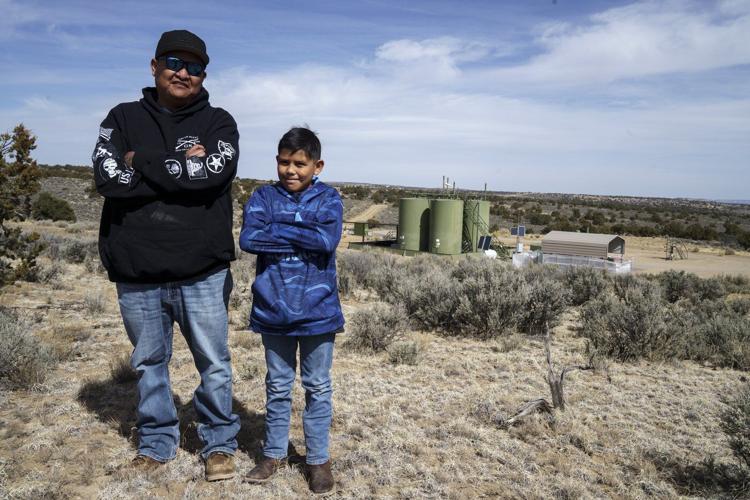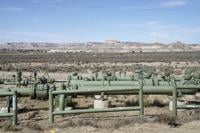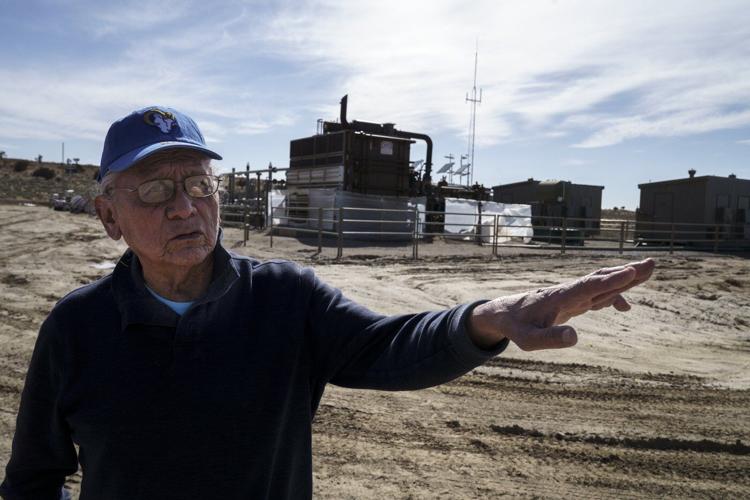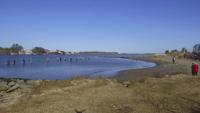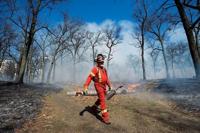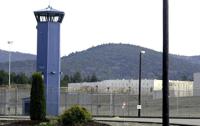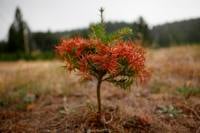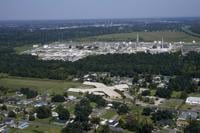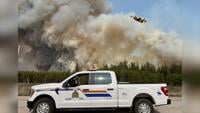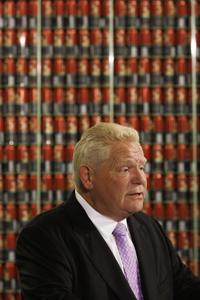COUNSELOR, N.M. (AP) — On a Tuesday in March, Billton Werito drove his son Amari toward his house in Counselor, New Mexico, navigating the bumpy dirt road that winds through a maze of natural gas pipelines, wellheads and water tanks. Amari should have been in school, but a bout of nausea and a dull headache kept him from class.
“It happens a lot,” Amari explained from the backseat, glancing up from his Nintendo Switch. The symptoms usually show up when the sixth grader smells an odor of “rotten egg with propane” that rises from nearby natural gas wells and wafts over Lybrook Elementary School, where he and some 70 other Navajo students attend class. His little brother often misses school for the same reason.
“They just keep getting sick,” Amari’s father, Billton, said. “I have to take them out of class because of the headaches. Especially the younger one, he’s been throwing up and won’t eat.” The symptoms are putting the kids at risk of .
Lybrook sits in the heart of New Mexico’s San Juan Basin, a major oil and gas deposit that, along with the Permian Basin in the state’s southeast, is supplying natural gas that meets much of the nation’s electricity demand.
The gas pulled from tens of thousands of wells in New Mexico has reaped huge benefits for the entire country. Natural gas has become a go-to fuel for power plants from coast to coast, sometimes replacing dirtier coal-fired plants and, by extension, improving air quality. Locally, oil and gas companies employ thousands of workers, often in areas with few other opportunities, all while boosting the state’s budget with billions in royalty payments.
But those benefits may come at a cost for thousands of students in New Mexico whose schools sit near oil and gas pipelines, wellheads and flare stacks. An Associated Press analysis of state and federal data found 694 oil and gas wells with new or active permits within a mile of a school in the state. This means around 29,500 students in 74 schools and preschools potentially face exposure to noxious emissions, since extraction from the ground can release unhealthy fumes.
A measurable effect on students
At Lybrook, where Amari just finished sixth grade, fewer than 6% of students are proficient at math, and only a fifth meet state standards for science and reading proficiency.
Other factors could help explain students’ poor achievement. Poverty rates are higher in some areas with high levels of gas development, and students at rural schools overall tend to face challenges that can adversely affect academic performance. AP’s analysis found two-thirds of the schools within a mile of an oil or gas well are low-income, and the population is around 24% Native American and 45% Hispanic.
But research has found student learning is directly harmed by air pollution from fossil fuels — even when socioeconomic factors are taken into account.
The risks go far beyond New Mexico. An AP analysis of found over 1,000 public schools across 13 states that are within five miles of a major oil or gas field. Major fields are collections of wells that produce the highest amount of energy in a state.
“This kind of air pollution has a real, measurable effect on students,” said Mike Gilraine, an economics professor at Simon Fraser University in Vancouver, Canada, who studies connections between air quality and student performance.
In 2024, Gilraine co-wrote a study showing student test scores were closely associated with air contamination. Each measured increase in PM2.5, a type of pollution created from the burning of fossil fuels, was associated with a significant decline in student test scores, Gilraine found. Conversely, researchers have documented that reductions in air pollution have led to higher and fewer .
“To me, the surprise was certainly the magnitude of the effects” of air pollution on students, Gilraine said. “It’s hard to find a similar factor that would have such an impact on schools nationwide.”
America’s shift to natural gas has resulted in substantial increases in student achievement nationwide, Gilraine’s research shows, as it has displaced dirtier coal and led to cleaner air on the whole. But there has been little data on air quality across New Mexico, even as it has become one of the most productive states in the nation for natural gas. State regulators have installed only 20 permanent air monitors, most in areas without oil or gas production.
Independent researchers have extensively studied the air quality near schools in at least two locations in the state, however. One is Lybrook, which sits within a mile of 17 active oil and gas wells.
In 2024, scientists affiliated with Princeton and Northern Arizona universities conducted an air-monitoring study at the school, finding that levels of pollutants — including benzene, a cancer-causing byproduct of natural gas production that is particularly harmful to children — were spiking during school hours, to nearly double the levels known to cause chronic or acute health effects.
That research followed a 2021 health impact assessment conducted with support from several local nonprofits and foundations, which analyzed the effects of the area’s oil and gas development on residents.
The findings were startling: More than 90% of people surveyed suffered from sinus problems. Nosebleeds, shortness of breath and nausea were widespread. The report attributed the symptoms to the high levels of pollutants that researchers found — including, near Lybrook, hydrogen sulfide, a compound that gives off the sulfur smell that Amari Werito associated with his headaches.
Those studies helped confirm what many community members already knew, said Daniel Tso, a community leader who served on the committee that oversaw the 2021 health impact assessment.
“The children and the grandchildren need a safe homeland,” Tso said during an interview in March, standing outside a cluster of gas wells within a mile of Lybrook Elementary.
“You smell that?” he said, nodding towards a nearby wellhead, which smelled like propane. “That’s what the kids at the school are breathing in. I’ve had people visiting this area from New York. They spend five minutes here and say, ‘Hey, I got a headache.’ And the kids are what, six hours a day at the school breathing this?”
Lybrook school officials did not respond to requests for comment.
Despite risks, oil and gas can pump money into schools
Researchers have identified similar air quality problems in New Mexico’s southeast.
In 2023, a team of scientists from a coalition of universities conducted a detailed, yearlong study of the air in Loving, a small town in the Permian Basin. Local air quality, researchers found, was worse than in downtown Los Angeles, and the tested air contained the fifth-highest level of measured ozone contamination in the U.S.
The source of the ozone — a pollutant that’s to children — was the area’s network of gas wells and related infrastructure. Some of that infrastructure sits within a half-mile of a campus that houses Loving’s elementary, middle and high schools.
A small group of residents has spoken out about the area’s air quality, saying it has caused respiratory problems and other health issues. But for most locals, any concerns about pollution are outweighed by the industry’s economic benefits.
Representatives of the oil and gas industry have claimed the air quality studies themselves are not trustworthy.
“There needs to be a robust study to actually answer these questions,” said Andrea Felix, vice president of regulatory affairs for the New Mexico Oil and Gas Association (NMOGA). Felix said other sources of emissions, such as cars and trucks, are likely a larger source of air quality problems near wells.
“Companies follow the best available science” for well placement and emissions controls, Felix said, and also contribute huge amounts of money to the state’s education budget. In the most recent fiscal year, oil and gas revenue supported $1.7 billion in K-12 spending in New Mexico, according to a NMOGA report.
Officials with Loving Municipal Schools are also skeptical of the alarm over the wells. Loving Superintendent Lee White said the school district used funds from the oil and gas industry to pay for a new wing at the elementary school, a science lab for students, turf on the sports field and training and professional development for teachers. He said the industry’s contributions to state coffers can’t be ignored.
“Are we willing to give that up because people say our air is not clean?” he said during an interview. “It’s just as clean as anywhere else.”
As White spoke, a drill rig worked a couple of miles east of Loving’s elementary school while parents poured into the gymnasium to watch kindergartners collect their diplomas. White touted the district’s success, saying the elementary school scores above state averages for reading, math and science proficiency, while Loving’s high school students far outpace the state average for college and career readiness.
But environmental groups, attorneys and residents continue to push for limits on drilling near schools.
Those efforts saw a boost in 2023, when New Mexico State Land Commissioner Stephanie Garcia Richard issued an executive order prohibiting new oil and gas leases on state-owned land within a mile of schools.
Industry representatives decried the move, saying it added potentially insurmountable costs and barriers to drilling operators. However, AP’s analysis found that relatively few wells would be impacted even if the rule applied to all of New Mexico; only around 1% of oil and gas wells in the state are within a mile of a school.
In the years since, residents of areas where exploration is heavy have lobbied for legislation prohibiting gas operations within a mile of schools, regardless of land status. That bill died in committee during the most recent session of the New Mexico legislature.
Advocates have also sued the state over an alleged lack of pollution controls. That lawsuit is currently pending in state court.
____
AP journalist Sharon Lurye contributed to this report from New Orleans.
____
The Associated Press’ education coverage receives financial support from multiple private foundations. AP is solely responsible for all content. Find AP’s for working with philanthropies, a of supporters and funded coverage areas at .

